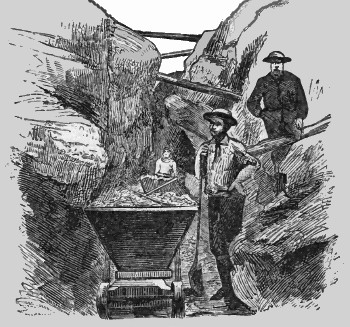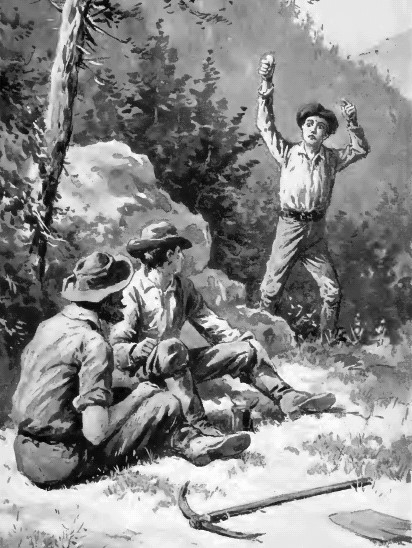The Tombstone mining district is nearly eight miles east and west, and about five miles north and south. On the western edge of the district, along the San Pedro river, silver ore had been discovered as far back as 1859, but the hostility of the Indians prevented any development. The country in which the mines of Tombstone are situated may be described as a series of rolling hills, which have a gradual ascent until they merge into the Mule mountains on the south, and stretch away in an undulating plain to the Dragoon range on the north. The geological formation of the district presents many features worthy of study. Porphyry appears to be the predominating rock, though a capping of lime overlies the leading mines of the camp. Quartzite is found everywhere, and a granitic formation is met with on the western edge of the district. As depth is attained, the surface lime disappears and porphyry and quartzite constitute the country rock. A notable feature of the Tombstone mines is the size of the veins and the ease with which the ore is reduced. The silver occurs as cerargyrite, a chloride with very little base combinations, and can be worked by pan process, to 90 per cent, and upwards. The cost of extraction is merely nominal, and the facilities for reduction are all that could be desired. The present output of bullion is over $500,000 per month, from 140 stamps. This yield is being steadily increased, and valuable paying properties are being added to the list of bullion producers every mouth. It is estimated that the bullion yield for the present year will amount to $7,000,000. This is a good showing for a camp a little over three years old, which did not drop a stamp until June, 1879. The daily output of ore at the present time is about 500 tons. Fourteen of the leading mines have complete hoisting-works with the latest improved machinery. Water has been struck in several claims at a depth of between 500 and 600 feet, but the inflow is as yet very light, and no difficulty is experienced in getting rid of it. There are over 3,000 locations in Tombstone district. In this brief sketch there are doubtless many promising properties deserving of notice besides those mentioned, but space will not admit of a separate description of each.
The Tombstone Gold and Silver Mining Company own the Lucky Cuss, the East Side, Tribute, and Owl's Nest. This group constitutes one of the most valuable properties in the district. The Tough Nut, the leading mine, is thoroughly opened by shafts, drifts, winzes, and open cuts. Immense ore bodies, sometimes 20 feet in width, are met with. The ore is found in spar and quartz, and is said to average $100 per ton. The company have two mills on the San Pedro, one of 10 and another of 20 stamps. It has paid dividends from the start, and has a large surplus on hand. This is the first organized company in the district. It employs about 125 men, and its production of bullion up to date, is said to be about $1,000,000. The Grand Central Company's property is embraced in a claim 1500 feet in length and 600 feet in width. It is incorporated under the laws of Ohio, with a capital of $10,000,000, divided into 100,000 shares. It is a magnificent property. The vein is from 8 to 12 feet wide, and runs from $80 to $100 per ton. The main shaft is down 500 feet, with three levels—500, 1100, and 600 feet, respectively. The reduction works consist of 30 stamps on the San Pedro, which are kept constantly at work. While only in operation a few months, it is estimated that $500,000 has already been produced. Regular dividends are declared, and the property is steadily increasing in value as depth is reached. The Western Company own the Contention, one of the first locations in the district, which has produced a large amount of bullion. The property joins the Grand Central on the north. The writer was not permitted to see the mine, and therefore can say nothing definite about its present condition.
The Girard has a shaft 400 feet in depth and a vein from 4 to 6 feet in width. The ore is of high grade and has milled $100 per ton. The property is incorporated in Jersey City with a capital of $2,000,000, divided into 200,000 shares. The company have put up tine hoisting-works and will soon have a mill in operation on the San Pedro. The Head Center embraces 1,300 feet in length and 500 feet in width. It is incorporated under the laws of the State of California with a capital of $10,000,000, in 200,000 shares. The vein averages from 4 to 8 feet, yielding about $70 per ton, about 45 per cent, of the bullion being gold. The company own a 10-stamp mill near Contention City. The main shaft is down 600 feet. The first level is 500 feet, the second 400, and the third 500. Hoisting machinery of the most improved pattern has been erected. The Vizina is incorporated under the laws of the State of New York on a basis of $5,000,000 and 50,000 shares. The mine is opened by three shafts, the deepest being about 400 feet. It is the intention of the company to erect a mill at an early day. Meanwhile the mine is being thoroughly opened. Over $200,000 has already been taken out from ore worked in a custom mill. Fine hoisting machinery has been erected, and the work of development is pushed forward steadily. The Empire is bounded on the south by the Sulfide and the Girard. It is incorporated under the laws of Massachusetts. The main shaft is down 450 feet and has struck a large body of high-grade ore.
A hoisting engine, with a capacity to sink 1,200 feet, has been put up, and this valuable property is being thoroughly opened. The Sulfide adjoins the Empire and the Head Center., It is incorporated under the laws of Pennsylvania. Its main shaft is down GOO feet. It has a fine location; has first-class hoisting-works, and is being opened in a systematic manner. The Bob Ingersoll, one of the most valuable claims in the district, shows 5 feet of ore that will mill $100 per ton. It has a shaft down 200 feet, and is steadily improving as it is being sunk upon. This mine is incorporated. The Sydney is a fine looking property with a vein 12 feet wide, 4 feet of which is ore that goes from $50 to $100 per ton. The mine is owned by San Francisco parties. The Grand Central South has a shaft 250 feet in depth. It is a large vein adjoining the Grand Central, and is considered by many the coming mine of the camp. It is incorporated in San Francisco.
The Tranquility joins the Empire and the Girard on the west. It has expensive hoisting-works, and is showing some very fine ore. None of the stock of this mine is on the market. The Flora Morrison is bounded on the east by the Grand Central. It is incorporated under the laws of Pennsylvania; 250,000 shares, $2 per share. It has a shaft 300 feet deep, besides drifts, cross-cuts, and winzes, and is showing fine ore. The Way Up has a shaft 300 feet, and is producing ore of a high grade. It is incorporated in New York; 150,000 shares, $10 per share. The Lucky Cuss, one of the first locations in the district, has a shaft 300 feet, and over 500 feet of drifts and cross-cuts. It has produced some of the richest ore ever taken out in the camp, and yielded about $50,000. The Sunset, south of the Lucky Cuss, has produced over $50,000. The Wedge shows a vein 3 feet wide, of high-grade ore. It has a shaft 100 feet deep, which is steadily pushed downwards. The mine is incorporated. The Gilded Age adjoins the Goodenough, and embraces a large portion of the town site. It has one shaft down 100 feet, which has produced rich ore. The Mountain Maid has a vein from 2 to 4 feet, and runs from $50 to $300 per ton. It has 3 shafts, the deepest being 200 feet. Like the Gilded Age, it extends across the town site. Among the many other claims in the immediate vicinity of the town, may be mentioned the Cincinnati, Grand Dipper, Naumkeg, Hawkeye, Plum, Rattlesnake, Wide West, Topaz, Omega, Omaha, Alpha, Prompter, Sunrise, Parallel, Little Wonder, Revenue, Survey, Defense, and hundreds of others worthy of mention here if the space permitted. Many of these claims are steadily and surely developing into fine paying properties.
In the western portion of the district are several well-defined and valuable mines showing rich ore and large veins. The following are the most prominent: Owl's Nest, carrying 3 feet of ore that goes from $50 to $80 per ton. This claim has 3 shafts, the deepest being 100 feet. It is owned by the Tombstone Mining Company. The Junietta has a 2-foot vein assaying $150 per ton. The deepest shaft is 100 feet. The Silver Bell has a shaft 50 feet, and carries ore worth $100 per ton. The Stonewall has a large ore body that has yielded $75 per ton. It has a shaft 120 feet. The Monitor is a 6-foot vein of free-milling ore, going $40 per ton, with a shaft 120 feet, in a granite formation. The Merrimac has 4 feet of ore that has milled $60, It has two shafts 60 feet each, and one 40 feet. Both these claims belong to the Monitor Mining Company, an Eastern incorporation. The True Blue is a 2-foot vein of $100 ore, with a shaft 200 feet. The Lucknow has a shaft 50 feet, and has ore that averages $50 per ton. The Delhi, Miami, Franklin, Randolph, Red Top, Argenta, Three Brothers, and many others, are in this neighborhood, and are well worthy of notice.
Three miles from the San Pedro, is another group of mines which are producing remarkably rich ore. The Bradshaw, in its bullion yield and development, is the best known of these claims. It is a large vein, carrying ore that works from $80 to $100 per ton. It has been sunk to a depth of 400 feet; has improved hoisting machinery, and has already produced nearly $50,000. It is owned by an incorporated company in San Francisco. A 10-stamp mill is nearly completed, and the mine promises to be one of the regular bullion-producers of the district. The Alkey is a 4-foot vein, producing ore worth $100 per ton. It has a 50-foot shaft. The Bronkow, the first location in the district, is a vein 6 feet wide. It has a shaft 60 feet deep. Continual litigation has retarded the development of this property. In this necessarily brief resume, full justice can not be done to the immense silver veins of Tombstone district. The salient points only have been given; but to have a proper conception of the size, richness, and extent of the veins in this wonderful camp, a personal examination is necessary. It is safe to say that nowhere on the coast have there been found ore bodies larger, richer, or more extensive. There are hundreds of fine prospects as yet undeveloped, which give every indication of being valuable, and which offer admirable opportunities for investment.
Return
to The Arizona Page:
Arizona Gold Rush Mining History



